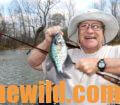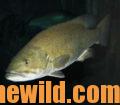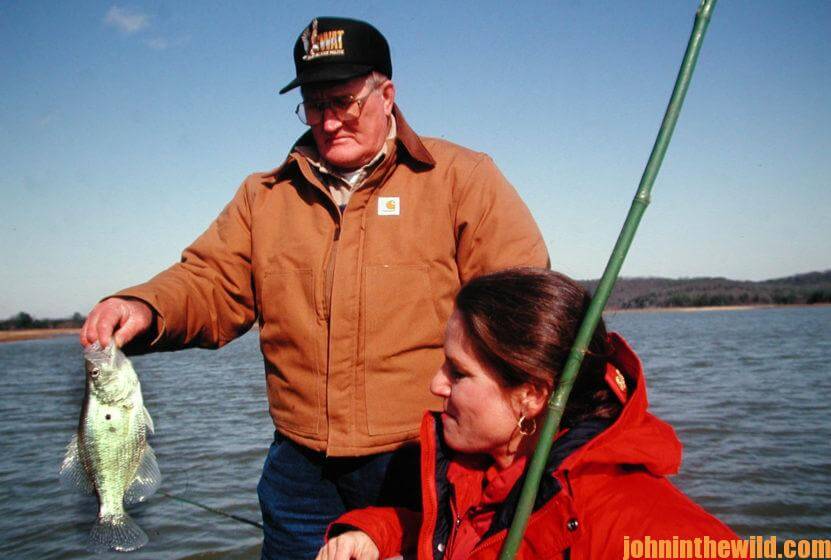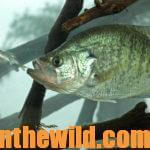Editor’s Note: This fall there’s been almost never-before very-high temperatures in the 90+ range. Where I live near Birmingham, Alabama, we’ve had 6 weeks of 95+ temperatures from late August through the first part of October. So, crappie fishermen must use summertime tactics to catch October crappie across much of the South. In other sections of the country, anglers will catch crappie with fall strategies. With 4 feet of snow falling in the U.S. Northwest the first week of October, some anglers must use winter methods to catch crappie there. This week, we’ll look at catching crappie now. Today’s crappie anglers are catching more and bigger crappie than ever before by going deep for crappie, which takes planning, close observation and special lure techniques for warm-weather crappie.
Nolen Shivers – Fishing Stumps and Docks:
 Veteran angler, Nolen Shivers of Birmingham, Alabama, fishes for bass avidly during the spring and summer. However, during the prespawn, he prefers to fish for crappie. According to Shivers, “I can catch more crappie in the cold months’ prespawn than I can bass. I think that catching any kind of fish is a lot better than not taking fish. Besides, I like to eat crappie.”
Veteran angler, Nolen Shivers of Birmingham, Alabama, fishes for bass avidly during the spring and summer. However, during the prespawn, he prefers to fish for crappie. According to Shivers, “I can catch more crappie in the cold months’ prespawn than I can bass. I think that catching any kind of fish is a lot better than not taking fish. Besides, I like to eat crappie.”
Shivers takes prespawn crappie by fishing shallow, underwater stumps along creek and river channels, often 20 to 30 yards from the bank, or brush shelters under docks. “I’ve found that crappie come up out of the deep water and hold on underwater stumps along creek and river channels in 6-10 feet of water, waiting on the right water temperature to move into the bank to spawn,” Shivers reports. “Even when the crappie do spawn, the stumps are more productive than the banks. The crappie that are moving to the banks hold on the stumps before they go to the bank. Also the crappie that are coming away from the bank after they spawn hold on the stumps before they swim out to deep water.”
In Shivers’ other prespawn technique, he fishes docks. “Remember that most river residents who have docks usually build some kind of brush shelter or put some structure out in front of their docks, so they can come down and sit on their docks and catch fish. Most of the time the brush will be about a canepole’s distance or a little further from the dock. Having a depth finder will pay off for you. By motoring your boat back and forth in front of the dock, you usually can locate this sunken cover on your depth finder. The crappie will move into this type of structure during the prespawn because it gives them cover to hold on while they’re waiting on the temperature to warm up. If there’s no cover I can see4 in front of a dock, then I assume the cover is under the dock. Oftentimes a dock owner will sink the cover under the dock to keep the fish close to his pier. If you cast light jigs up under the dock, you can catch crappie.”
Travis Bunting on Missouri’s Cold-Weather Crappie Fishing:
Editor’s Note: Travis Bunting of Jefferson City, Missouri, a tournament crappie angler, enjoys catching cold-weather crappie.
From the time the water temperatures drop below 70 degrees in the fall until the water freezes-over, winter crappie fishing in central Missouri can be very productive. With the surface temperatures falling, the crappie will move to the banks. Here are some cold-weather tactics I use to catch crappie.
1) Use a Spring pattern in the Early Winter – In the early winter, we fish a typical spring pattern. My father and I will pick up our 7-foot B‘n’M Sam Heaton Poles (https://www.bnmpoles.com/) and start flipping shallow rock structure, both in open water and around docks. Normally, you can follow the crappie as they leave the banks and move into deeper water when the weather gets colder. Winter fishing is my favorite time of year to fish for crappie in Missouri because there’s very-little boat traffic then. You don’t have to fish the rough water made by the tourists’ boats. One of the most-productive ways to fish is flipping or shooting docks at this time of the year. The fish will suspend under the docks and hide in the shadows.
2) Downsize Everything, and Fish Docks – We like to use 5-foot SharpShooter Poles for several reasons. The SharpShooter works well for shooting docks. Because it’s only 5-foot long, in the winter, you easily can shoot the jig under the dock without hitting the dock. We like to use a 1/32- or a 1/64-ounce jig with a Southern Pro stinger (http://www.southernpro.com/). We also downsize our line to Berkley Fluorocarbon 4-pound test (http://www.berkley-fishing.com/). With the light jig, you need a light line for 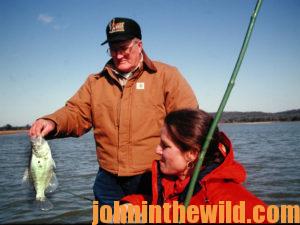 shooting distances.
shooting distances.
Most of the fish will be suspended from 3-5 feet down, no matter what the water depth is. Crappie get very spooky in the winter since the water clears-up so much due to the lack of boat traffic. So, if you catch one or two fish, and then they shut off, simply back off, go somewhere else, and return in an hour or so. Then the fish will have moved back up in the water column and become more active.
3) Concentrate on Structure – When that dock pattern starts to fail, move back to the structure. If the wind isn’t blowing, the best technique is generally to move out to 12-16 feet of water and fish brush piles. The hardest part of crappie fishing is dissecting a brush pile, trying to find the sweet spot. Once you’ve pinpointed the sweet spot, you may pull out 15 or 20 fish from an area no bigger than a 5-gallon bucket. That’s when we’ll pick up our 12-foot Buck’s Best Ultra-Lite Poles and start jig fishing. We like a 1/16-ounce Southern Pro Magnum jig, usually tipped with a Berkley Crappie Nibble (http://www.berkley-fishing.com). Fishing a typical up-and-down tactic vertically works the best, but sometimes floating your bait will pay crappie dividends. The trick is to hold your bait dead still and watch your line. The bite is normally so light that often you won’t feel the crappie pick up the jig.
4) Watch the Wind – If the wind is blowing, the fish become very predictable. If you can find a steep bank or a bluff that the wind is blowing directly into, you can load a boat with crappie in a hurry. The wind seems to blow the shad directly into the bank, and then the crappie soon will follow – whether or not there’s structure. The fish will be anywhere from on the bank to deep water. We like to position our boat approximately 20-feet from the bank and cast. We’ll start off bouncing the bottom and then fish for suspended crappie.
* More Tactics for Cold-Weather Crappie with Avid Anglers:
Cool-weather crappie fishing can be highly productive with plenty of fast action and big fish. These wintertime tips will pay off in more crappie.
1) Read the Weather – Several years ago, for 2 or 3 days, the weather had been pleasant as a warm front moved through Alabama where I lived. But the TV weatherman predicted that a major storm would hit before nightfall. My brother and I had been fishing a shallow-water beaver pond off a major river system with numbers of cypress trees growing in it. Because the pond was shallower than the river, the water in the beaver pond was warmer than the river water, and the crappie were more active there.
You, too, can take more cold-weather crappie once you locate beaver ponds, cut-offs, sloughs, coves and/or bays of major river systems. A warm spell during cold weather warms-up the water quicker in these shallow pockets. The crappie will hold on submerged trees, stumps and/or the roots of live trees. About 5 hours before the front was due to arrive when Archie and I were fishing, the crappie went on a feeding spree. But as soon as we felt the temperature drop only slightly, the crappie quit biting.
2) Locate the Thermocline – During cool weather, rivers may have their coldest water on the top, and the warmest water on the bottom. Because crappie seek a comfort zone, often they’ll be looking for warmer, deeper water in some type of cover where they can hide, concentrate and attack baitfish. To pattern these crappie, look for cover along the thermocline where crappie can hole-up. In many rivers, this cover may be on the edges of old creek and river channels and along stump rows where the warmer water is close to the bottom. Remember during cooler months, the crappie’s body metabolism slows-down. The fish won’t chase a bait as far as it will in the spring and summer. The crappie angler has to fish his bait slowly and deep to get bites.
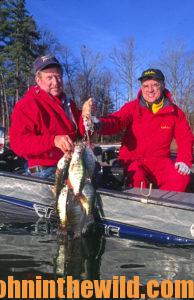 3) Use a Depth Finder – In Texas, my friend Bryan Duplechain catches plenty of big, fat, wintertime crappie in 30 to 40 feet of water by fishing minnows on humps and creek channels. “I think cold weather is the best time to catch crappie,” Duplechain says. “I know exactly where the crappie must be, because crappie are searching for bottom breaks with plenty of oxygen in deep water and a comfortable water temperature. With a depth finder, these deep-water crappie are easier to locate, and I usually find them in large schools.”
3) Use a Depth Finder – In Texas, my friend Bryan Duplechain catches plenty of big, fat, wintertime crappie in 30 to 40 feet of water by fishing minnows on humps and creek channels. “I think cold weather is the best time to catch crappie,” Duplechain says. “I know exactly where the crappie must be, because crappie are searching for bottom breaks with plenty of oxygen in deep water and a comfortable water temperature. With a depth finder, these deep-water crappie are easier to locate, and I usually find them in large schools.”
4) Cast for Crappie – If an angler has studied deep-water structure and knows where stump rows and old creek channels usually home good schools of crappie, he can fish these areas in cold weather by casting and retrieving. The late Elbert Parker, a long-time guide on the Alabama/Georgia border, probably was one of the best wintertime crappiers I ever met. He fished the shoreline and open water and had pinpointed the brush, stumps and underwater structure in the three rivers making up Lake Weiss on the Alabama/Georgia border.
“During cold weather, crappie will get down in and under the stumps and their roots along the old river and creek channels,” Parker told me. “These fish may not show up on a depth finder because of where they’re holding. Crappie hit very lightly in the winter. You must be able to see your line as the jig falls, since the papermouths often will take the jigs on the fall. If a crappie doesn’t take a jig on the fall, then I’ll use a slow, easy retrieve – trying to bump the cover without getting hung-up. But if you’re not losing jigs, then you’re not fishing where the crappie are.”
5) Realize Concrete Attracts Crappie – In cold weather, large concrete structures like bridge abutments and railroad trestles absorb heat and then transfer that heat into the water. Crappie will move to creek channels, river channels and ledges to feed and find a warmer environment at those places when the water’s cool. Most bridges and trestles have at least one concrete column just on the edge of an old creek or river channel that they cross. Naturally, as crappie migrate up and down that creek or river channel, they’ll find the warm water the concrete piling has caused and locate the baitfish holding on that piling for warmth and food. Although crappie will be on pilings further away from the creek channel, usually the pilings closest to the creek channel home the best crappie fishing during cold weather. Most of the crappie will be holding on the calm-water side of these concrete structures where the water’s warmer and the baitfish more abundant. Crappie may be holding on the calm-water side to rest and feed out of the current.
Crappie position themselves on concrete structures at different depths during various times of the year. You can motor your boat along the edge of the concrete while reading your depth finder to see the crappie and determine at what depth they are. However, if the crappie are holding close to the structure, you won’t be able to spot them on the depth finder. Also if the fish are shallow, I believe they can be spooked by being run over with a boat.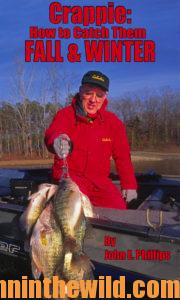
In cool weather, I’ll start off by assuming that the crappie are holding shallow on the concrete. If I’m jig fishing, I’ll anchor my boat upstream of a piling and cast downstream, letting my jig fall right beside the concrete piling. On each cast, I’ll count my jig down and then begin to retrieve. The first cast and retrieve will be right below the surface of the water, because often on a bright, warm day – even in cold weather – crappie may be only a foot or two under the surface. Keep the jig bumping the concrete as long as possible during the retrieve.
When fishing live bait in the winter, keep the minnow in contact with the concrete to have more bites. Anchor your boat out either a pole or a rod’s length from the structure, and set your cork or fish a tight line at various depths to determine at what depth the crappie are feeding. Once you start getting bites, change out all your lines to have the baits placed at the depth where crappie seem to be holding.
To learn more about crappie fishing in the fall and winter, check out John E. Phillips’ book, “Crappie: How to Catch Them Fall & Winter,” available in Kindle, print and Audible at http://amzn.to/16AzIZi.

